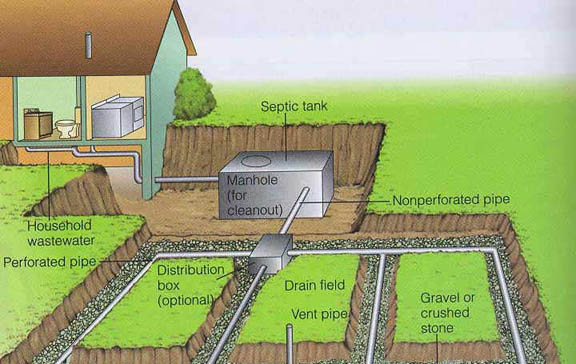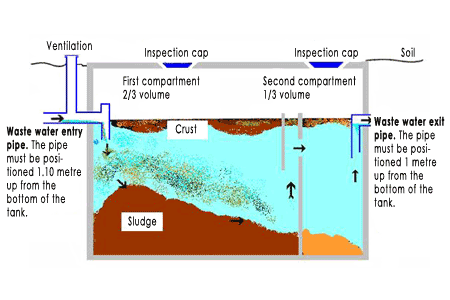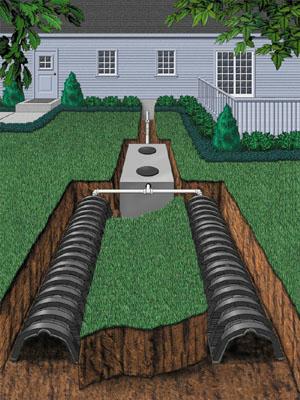Learn More About Septic Systems
Do you know where the water goes when you empty a sink or flush a toilet? If your home is in a city, the wastewater goes into a municipal sewer system and to a sewage treatment plant. If your home is in a rural area or a small community, chances are your wastewater goes to your own private septic system. A septic system treats and disposes of your sewage right in your own yard.
The septic system, if properly sited and when performing properly, safely treats and disposes of your sewage without creating any danger to your health or to the environment. Normally you don't have to worry about sewage in your yard. However, if the septic system is not functioning properly, there can be health concerns. Therefore, it is a good idea to understand how a septic system works and what you can do to make sure it continues to work properly.
How A Septic System Works
The purpose of a septic system is to treat household waste using natural processes. A septic system with an absorption field is the most common method for treating waste from a rural residence.
A typical septic system has three main components:
- a plumbing collection system
- a septic tank
- a drain field

Plumbing: Wastewater Collection
All wastewater containing human wastes, nutrients, dirt, and other contaminants must be collected and delivered to the septic tank and drain field for treatment and disposal. All water used in bathing, toilets, laundry, and dishwashing must be treated by the system. Drains allowing wastewater to enter the system should be equipped with strainers and other filtration devices to reduce the amount of food particles, hair, and lint entering the system.
Septic Tank: Wastewater Separation

The purpose of the septic tank is to separate the solids from the liquids in the wastewater stream and to begin the process of breaking down contaminants. The tank is a buried, watertight container typically constructed of concrete, steel, fiberglass or polyethylene and can range in size from about 1,000 to 1,500 gallons or more. To give you an idea of how large this is, consider that up to 50 gallons of water fit in a standard bathtub and ordinary toilets use up to 3.5 gallons per flush. So, depending on the size of your household, it doesn't take too long to fill the septic tank.
When the influent enters the first chamber, its velocity slows so that the heavier solids can settle out of the water into the bottom of the chamber, and lighter materials can float to the surface. The accumulation of settled solids at the bottom of the tank is called sludge and the lighter solids (greases, fats and soaps) which form a mass on the surface of the liquid in the septic tank is called scum. In between the sludge and the scum is liquid waste or wastewater.
Micro-organisms, like bacteria, and other natural processes act to decompose the waste materials in the liquid waste. Incoming water should be held in the tank for at least 24 hours in order to improve settling. Up to 50 percent of the solids will decompose into liquids and gases. Sludge and scum are also digested and compacted into a smaller volume. This is the first step in the process of purifying your household wastewater.
When the first chamber of the tank becomes filled, the liquid waste begins to fill the second chamber. The chambers of the septic tank are designed to prevent the movement of sludge and scum to the second chamber, allowing only the movement of liquid. Once the second chamber is filled, and more influent enters the first chamber, an equal amount of the partly-treated liquid waste flows into the second chamber, while an equal amount flows out of the second chamber into the leaching bed or drain field. The water flowing out into the leaching bed is called effluent. This is often referred to as primary treatment.
The Drain field: Wastewater Distribution

The majority of the treatment of the wastewater occurs in the drain field. A grid work of perforated pipes or clay tiles in the leaching bed area evenly distributes the effluent over the natural soil or imported fill. Sometimes a distribution tank is used at the head of the pipes to more evenly distribute the effluent to the pipes. Gravel supports and forms an envelope around the pipe, to protect it from roots and burrowing animals. The perforations in the pipe allow the effluent to escape to the soil. Uncompacted, unsaturated, undisturbed soil must surround the soil treatment system. This system, typically referred to as secondary treatment, may be a series of trenches or a mound.
As the effluent filters through the soil, microorganisms in the soil digest and remove the remaining impurities (such as suspended solids, organic chemicals and viruses and/or bacteria). There are millions of naturally-occurring beneficial microscopic organisms in every tablespoon of soil that kill disease-causing organisms in the sewage and remove nutrients. These beneficial bacteria in the soil need air to live. Therefore, a zone of unsaturated soil must be present below the drain field for complete treatment.
Proper Maintenance of Your System

As a homeowner, you’re responsible for the maintenance of your septic system. If properly designed, constructed and maintained, your septic system should provide long-term, effective treatment of household wastewater. A malfunctioning system is not only a health hazard to your family and your neighbors, but will likely harm surface and ground water resources, and cost you thousands of dollars to repair or replace. Keep in mind that when you sell your home, your septic system must be in good working order.
Septic System Evaluation
You should have a typical system evaluated at least every 3 years, including pumping by a professional. An evaluation should include:
- Locating the system
- Uncovering access holes
- Flushing the toilets
- Checking for signs of back up
- Measuring scum and sludge layers
- Identifying any leaks
- Inspecting mechanical components
- Pumping the tank
Pumping the Tank
Septic systems cannot dispose of all the material that enters the system. Solids that are not broken down by bacteria begin to accumulate in the septic tank and eventually need to be removed. As the septic system is used, sludge will build up in the bottom of the septic tank. The rate of the build-up will depend on the size of your tank (bigger is better), the volume of wastewater entering the tank, and the volume of solids in the wastewater stream.
If the sludge is allowed to accumulate to the height of the outlet pipe, it could flow into the next chamber and then out into the tile bed. The pipes in the tile bed can become rapidly clogged by sludge. When the pipe is all blocked and the wastewater can no longer leach into the soil, it will seep to the surface of the ground, or worse yet, back up into your house. Not only can a clogged septic system be hazardous to the environment and to your family's health, it also represents a very expensive repair bill. Once the pipes become clogged, there is no quick fix; the entire system must be dug up and replaced.
